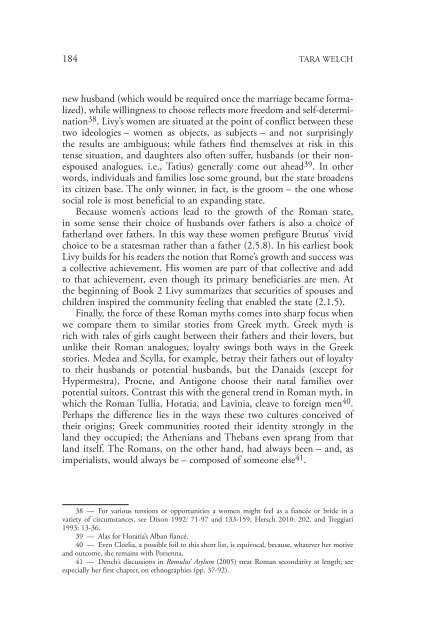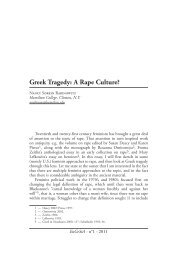Perspectives On and Of Livy's Tarpeia - EuGeStA
Perspectives On and Of Livy's Tarpeia - EuGeStA
Perspectives On and Of Livy's Tarpeia - EuGeStA
You also want an ePaper? Increase the reach of your titles
YUMPU automatically turns print PDFs into web optimized ePapers that Google loves.
184 TaRa WeLCh<br />
new husb<strong>and</strong> (which would be required once the marriage became formalized),<br />
while willingness to choose reflects more freedom <strong>and</strong> self-determination<br />
38 . Livy’s women are situated at the point of conflict between these<br />
two ideologies – women as objects, as subjects – <strong>and</strong> not surprisingly<br />
the results are ambiguous: while fathers find themselves at risk in this<br />
tense situation, <strong>and</strong> daughters also often suffer, husb<strong>and</strong>s (or their nonespoused<br />
analogues, i.e., Tatius) generally come out ahead 39 . In other<br />
words, individuals <strong>and</strong> families lose some ground, but the state broadens<br />
its citizen base. The only winner, in fact, is the groom – the one whose<br />
social role is most beneficial to an exp<strong>and</strong>ing state.<br />
Because women’s actions lead to the growth of the Roman state,<br />
in some sense their choice of husb<strong>and</strong>s over fathers is also a choice of<br />
fatherl<strong>and</strong> over fathers. In this way these women prefigure Brutus’ vivid<br />
choice to be a statesman rather than a father (2.5.8). In his earliest book<br />
Livy builds for his readers the notion that Rome’s growth <strong>and</strong> success was<br />
a collective achievement. his women are part of that collective <strong>and</strong> add<br />
to that achievement, even though its primary beneficiaries are men. at<br />
the beginning of Book 2 Livy summarizes that securities of spouses <strong>and</strong><br />
children inspired the community feeling that enabled the state (2.1.5).<br />
finally, the force of these Roman myths comes into sharp focus when<br />
we compare them to similar stories from Greek myth. Greek myth is<br />
rich with tales of girls caught between their fathers <strong>and</strong> their lovers, but<br />
unlike their Roman analogues, loyalty swings both ways in the Greek<br />
stories. Medea <strong>and</strong> scylla, for example, betray their fathers out of loyalty<br />
to their husb<strong>and</strong>s or potential husb<strong>and</strong>s, but the danaids (except for<br />
hypermestra), Procne, <strong>and</strong> antigone choose their natal families over<br />
potential suitors. Contrast this with the general trend in Roman myth, in<br />
which the Roman Tullia, horatia, <strong>and</strong> Lavinia, cleave to foreign men 40 .<br />
Perhaps the difference lies in the ways these two cultures conceived of<br />
their origins: Greek communities rooted their identity strongly in the<br />
l<strong>and</strong> they occupied; the athenians <strong>and</strong> Thebans even sprang from that<br />
l<strong>and</strong> itself. The Romans, on the other h<strong>and</strong>, had always been – <strong>and</strong>, as<br />
imperialists, would always be – composed of someone else 41 .<br />
38 — for various tensions or opportunities a women might feel as a fiancée or bride in a<br />
variety of circumstances, see dixon 1992: 71-97 <strong>and</strong> 133-159, hersch 2010: 202, <strong>and</strong> Treggiari<br />
1993: 13-36.<br />
39 — alas for horatia’s alban fiancé.<br />
40 — even Cloelia, a possible foil to this short list, is equivocal, because, whatever her motive<br />
<strong>and</strong> outcome, she remains with Porsenna.<br />
41 — dench’s discussions in Romulus’ Asylum (2005) treat Roman secondarity at length; see<br />
especially her first chapter, on ethnographies (pp. 37-92).



